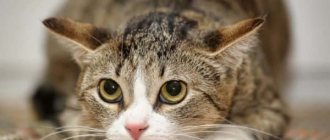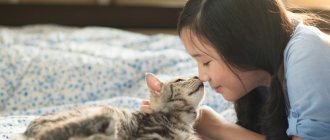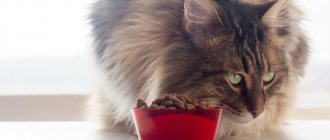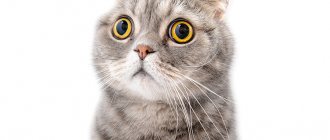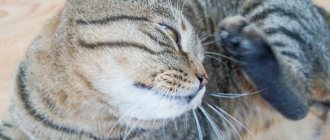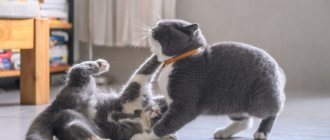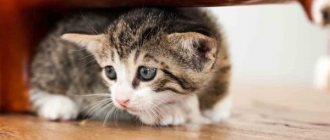Purring heals
Everyone also knows that cats purr with pleasure when everything is fine with them - their belly is full, it’s calm, it’s warm, and their owner gently strokes their fur. But the mustachios turn on their motor and in moments of trouble and pain - giving birth cats, injured and even dying animals purr.
This fact, by the way, confirms the theory about the healing properties of a cat’s purring. There is an assumption that a purring cat produces a certain hormone that acts on the animal as an analgesic and sedative. And some owners claim that their pet’s purring helps them get rid of pain and malaise.
By the way, this is how the continuous vibrating cat sound differs from the short purring - the same one for which Kuprin’s Yu-yu became famous. Do you remember how she interacted with the owners? Her short “murrm” meant “follow me,” “mrm” meant gratitude, “mrum” meant “I’m thirsty,” and “murrum” meant reproach. These sounds are similar to meows and are used by cats to communicate.
Why do cats purr when they're around people?
Why do cats often purr when people are sitting next to them? In general, this is a good signal for pet owners. This way it becomes clear that the cat feels good, cozy, safe with these people, she is happy with her life and the care she receives. Owners who are well acquainted with the nature of cats know that a loud purr means gratitude, and a quiet one simply means the pet is in a good mood or, perhaps, some kind of request.
When cats heal themselves, they purr and heal others around them. It’s not for nothing that they say that cats can cure a person from many diseases, including psychological ones. Thus, cats can cure depression or neurosis, reduce blood pressure and even relieve an attack of angina. Also, the purring of cats helps people with spinal diseases: they relieve pain from paralysis, arthritis, muscle atrophy, and even help astronauts rehabilitate after a flight.
Rarely do cat owners think about why their cute furry cats purr. They are just ready to give them a piece of delicious food for a session of calming purring, which helps get rid of anxiety, stress and just lift their spirits. Maybe that's why cats purr, to please their owners.
Cats heal people with their purring
Scientists from the Institute of Animal Communication in North Carolina (USA) have come to a clear conclusion - a cat should be in every home. She is a healer.
[advert]
For decades, scientists have studied cat voices. As a result of many experiments, it was established that a cat’s purring is not just an animal’s conversation, it is a powerful healing agent that allows it to quickly restore its strength and also heal wounds. It is purring that increases their vitality, and also has a beneficial effect on the human body, helping it fight various diseases.
➤ It has been proven that purring is a set of vibrations of certain frequencies that affect the activation of the protective forces of the human body. Surprisingly, but true, a cat’s purring helps strengthen (by 20%) and heal broken bones. It's all about the unique range of its “cooing” - from 27 to 44 hertz. ➤ Also, a cat’s purring has a beneficial effect on the human nervous system and psyche. ➤ In addition, it is with sounds emanating in this range that a person’s cerebral circulation improves, blood pressure normalizes, heart rate stabilizes, and immunity against colds increases. ➤ Cats not only relieve stress and help with depression, but also reduce withdrawal symptoms in drug addicts and alcoholics. ➤ Among other things, kitty helps against colitis, flatulence, gastritis, stomach ulcers, flu, insomnia, osteochondrosis, even frigidity and impotence. ➤ Cat owners live on average 4 to 5 years longer than cat owners. ➤ However, it should be noted that this applies to lovers of almost all animals. ➤ When the owner strokes his pet, bioenergetic contact occurs between them, positive impulses are sent to his central nervous system - his mood rises. ➤ Thanks to the cat’s habit of massaging with its claws, a person’s reflexogenic zones are irritated - the claws work in the same way as instruments during an acupuncture session. ➤ Again, it has been proven that cats living in the house have a beneficial effect on the health of children. Thanks to their presence in the child's body, antibodies are produced that help prevent childhood asthma. ➤ But for many allergy sufferers, animal fur is a powerful irritant; here you need to consult a doctor who will tell you how possible it is to communicate with cats. Convinced dog lovers can also express their reluctance to have a dog.
WHITE, BLACK, RED, BLUE... “Now cat therapy in the USA and especially in the UK is experiencing a real boom,” says artistic director of the “Cat House” theater, People’s Artist of the RSFSR Yuri Kuklachev. — The cat unmistakably guesses the owner’s sore spot and always lies down exactly on it. Moreover, cats of different breeds and colors have their own specialization.
Whites are considered universal. By the way, in England it was white murks that were recognized as medicinal. As experiments have shown, white cats are useful for lethargic people, they feed them with energy. Blacks, on the contrary, rid their owners of negative energy. They are well suited for temperamental, hot-tempered people. Also, these animals cope better than others with the functions of a protector and will warn of danger in time. Redheads cheer up their owners. Grays have equally the qualities of black and white cats. Persian cat. Low-active, apathetic cat, loves a calm environment. She can practice healing for a long time, but at the same time she takes away negative energy from the owner in small quantities. The Persian cat relieves a person from irritability and nervous breakdowns. They are considered excellent neurologists and can cure the owner of depression, insomnia and irritability. Angora cat. Affectionate, kind and non-aggressive. He is considered the best diagnostician and always accurately guesses the sore spot. She is capable of treating for a long time and sometimes does not leave her owner for hours. Sphinx . Peace-loving cat. The Sphynx is able to absorb a lot of negative energy at once and is considered one of the most talented healers among cats. perfectly treats diseases of the kidneys, stomach and intestines. Siamese cats can cure colds and infectious diseases. They have the gift of killing pathogenic microbes, which is still inexplicable to scientists. Russian blue. Affectionate, active, independent, but requires a lot of attention. It takes little energy, but is an excellent diagnostician. It should be noted that simple yard cats cope with human ailments just as well as their purebred counterparts. NOTE : It is well established that cats have a better healing effect than cats. Moreover, the former have a positive effect on people with diseases of the nervous system and internal organs, and the latter on those who suffer from osteochondrosis, radiculitis and arthrosis.
Getting a tutor
But let's return to cat lovers who ask how a person can learn to purr like a cat. Unfortunately, no one will be able to repeat this wondrous rattling the first time - simply due to different anatomy. And a cat will not voluntarily reveal its secret of how to purr to a person. But you can use a trick.
First of all, in order to learn to purr, you need to get a personal mustachioed tutor, if you don’t already have one. Did you start it? Now do everything to appease him: buy him the best food, a house, a “sports corner”, toys, a scratcher and scratching post with catnip, a running wheel, a pair of beautiful carriers for traveling to different distances and proclaim him the ruler of the Universe.
Clear the shelves
Cats are naturally curious. A pen, a set of keys, or fragile trinkets can attract the animal's attention and cause it to jump up to examine the “toy.” Keeping your shelves organized will help reduce your cat's interest in places where she doesn't need to be. In addition, this way you can protect your things, because pets are known for their habit of pushing objects from heights, but they do not have the habit of taking a broom and dustpan to remove fragments from the floor.
How does purring occur?
For a long time, the purring of cats remained a mystery to humans. And even now it is not fully studied.
Initially, scientists tried to find a separate organ that is responsible for producing vibrating sound. But nothing suitable was found. Then they decided that the sound was coming from the cats' stomachs! But they quickly rejected this misconception.
The modern official version is that purring occurs due to the contraction and vibration of muscles that are located near the vocal cords. This is caused by the arrival of certain impulses from the animal’s brain.
A number of systems are used to create such a unique sound:
- nose;
- mouth;
- hyoid bones;
- ligaments
Sound and vibration originate between the base of the skull and the tongue, and then spread throughout the body.
Interesting facts about cat purring
There are many interesting facts on this topic that few people know:
- There are situations in history when a pet could imitate simple monosyllabic sentences while purring. Of course, this is simple, but this fact is still quite unusual and interesting.
- Cats “talk” only when completely alone or in the presence of a person. If two animals are in the same room, they do not need this type of communication.
- Purring can be beneficial not only for the cat, but also for the owner. The sounds and vibrations of cats when you pet them have a beneficial effect on the human body: headaches, fatigue, apathy go away, even blood pressure can stabilize in some cases.
- When an animal purrs, the veterinarian cannot listen to the heartbeat; it simply cannot be heard. Therefore, doctors wait until the cat calms down or turn on the water to distract him.
It doesn’t matter how loudly or how long the pet “talks”, what matters is that it does it. After all, in this way a cat shows you its love, appreciation and trust. The animal thanks you for feeding, treating and caring for it in general.
Don't drive away the purring cat! Enjoy his “symphony”, relax your nervous system, become calmer, healthier and happier with him!
How can a person learn to purr like a cat?
Having understood the physiology of cats, you can try to transfer this knowledge to the human body. Is it possible to create such sounds with the help of our body? Unfortunately no.
The vocal cords of cats and humans are very different.
A person will never be able to purr like a cat because of the structure of the vocal cords - they are very different. Cats contract the muscles in their larynx, which moves their vocal cords. The process occurs instinctively, unconsciously, and it is impossible to learn.
Sound simulation
A person will not be able to purr like a cat, but you can imitate this sound. After all, a person is very good at imitation, and if he sets a goal, he can purr quite believably.
You should try saying "murrr" by vibrating your throat as you pronounce the "r". Do not cut off the word, but extend the sound as long as possible. As long as the lungs are enough.
The most important nuance in learning is the pronunciation of this drawn-out, throat-vibrating “r”. She needs to burr in the French manner. The technique is discussed in more detail in the article “how to learn to burr p.”
It is clear that the results will only vaguely resemble the purring of a cat, but this is all that human ligaments are capable of.
The cat's righting reflex
It is thanks to him that cats survive falling from very great heights. According to Wired Magazine, the main paradox is this: the greater the height of the fall, the greater the chance of survival. The practice is this: if a cat falls from the roof of a “classic” five-story building, most likely it will survive, but will be injured. But falling, for example, from the twelfth floor gives more chances. No magic, just naked physics. As the cat falls, it will momentarily feel weightless. These seconds are enough for the cat’s natural survival instincts to kick in, and the animal has time to “group” and give its body the only correct position for landing.
Why do we like this sound so much?
A person is often a very receptive creature with a subtle mental organization. When a cat comes to you and purrs, it is a sign that she is warm and comfortable next to you, that she feels safe and is not afraid of you. If we have a warm fluffy bundle of happiness and goodness next to us, then what else do we need? At least once in our lives, each of us has asked an unusual question: “How can I learn to purr like that?” Sometimes we feel so good and warm for various reasons that we just want to lie down next to our loved one, hug him and purr with happiness. We like this sound so much that we are ready to forgive our smaller brothers any mistakes and mischief, be it a torn sofa or a puddle in the most inappropriate place.
Find a replacement
A cat play set will provide your pet with the opportunity to jump, exercise and satisfy his curiosity. Stir up your cat's interest by changing her toys, the boxes she hides in, and introducing crumpled pieces of paper for her to chase. Be creative! Tower houses are also great for jumping and climbing exercises. It is important not to deprive the cat of the ability to jump. The ability to jump is built into her DNA and comes from ancestors who had to climb trees to escape predators and stalk prey before leaping. By equipping a special place for jumping exercises, you can wean your pet from other places where its presence is undesirable.
The therapeutic effect of purring
Experienced owners say that cats sense illness, and if the pet always sits on its stomach or chest, you should consult a doctor.
Psychologists distinguish such a concept as feline therapy - a method of treating or preventing various diseases through contact with a cat. Its effectiveness has been confirmed by numerous experiments.
Thus, American scientists have found that when a cat purrs, a person’s blood pressure and pulse normalize. And Russian zoologists have found that cat owners, according to statistics, live several years longer and suffer 20% less from problems with the cardiovascular system.
Today, feline therapy is especially popular for the treatment of diseases such as depression, anxiety, irritability and stress, and migraines.
How is it useful?
The benefits of purring and the ability of cats to heal have been known to people for a long time. Recent research at the intersection of bioacoustics and medicine has only confirmed empirical guesses. The animal treats the following diseases:
- nervous disorders;
- hypertension;
- arrhythmia;
- bone fractures;
- stomach diseases;
- obesity;
- gynecological diseases;
- alcoholism and drug addiction;
- edema of various etiologies.
Constant communication between a child and a pet prevents the occurrence of allergic reactions in the dermis.
For some people, cat fur is an allergen. However, American scientists, having conducted a number of studies, have proven that regular communication between a child from the age of 2 and a pet prevents the occurrence of allergic skin reactions and asthma. The habit of cats to massage the owner’s skin with their claws is a useful massage session in combination with acupuncture. Simple communication with an animal is healing for any age group, especially for the elderly, as it prolongs their life.
Cat-human interaction
The way a cat purrs depends on the person. A purring pet can trample its paws on its owner, lie down on top or next to it. All these actions have their explanation.
Showing affection
If you stroke your mustachioed pet, he will soon begin to purr. This means that he enjoys touch and communication with a person. When stroking against the grain or by a stranger, you can see the opposite effect. The animal will be angry or frightened and will hasten to leave with a threatening hiss.
Foot trampling
The most popular interpretation of trampling is the “milk step”. Kittens make similar movements on their mother's chest, stimulating the faster production of milk. Fingering with paws is also associated with:
showing gratitude and demonstrating trust in a person;
unrealized sexual instinct in castrated animals;
treating the owner or relieving one’s own stress;
preparing a comfortable place to sleep.
If your pet releases its claws when trampling, do not scold it. He does not control this action, so pet him and place a thick blanket or pillow under his paws.
Lying on or next to a person
Lying nearby is the highest form of trust and love. The animal feels safe with its two-legged owner. If a person is unwell, a furry pet can lie on top, sending its healing vibrations to the sore spot.
Main reasons
There are many versions that explain the reason for the rumbling of domestic cats. The following options are recognized as the main ones.
- Gratitude. Cats purr when they show gratitude to a person for treats, affection, touches and warmth. In this regard, a barely audible purr is a sign of a contented cat.
- Relaxed state. If the pet is in a calm state, then it begins to purr. The same situation can be observed when kittens, sitting in a calm and peaceful state, suck their mother’s milk. Since it is not possible to meow and eat food at the same time, they purr barely audibly.
- Showing your emotions. Most people believe that when a cat purrs, it means the cat is singing its song. With the help of different intonation, pronunciation of sounds and vibrations, pets demonstrate their mood at the current moment. This is comparable to people who, in a relaxed state, begin to hum certain tunes to themselves.
- Conversations between kittens and mother cat. With the help of rumbling, little children tell their mother that everything is fine with them, they are full and satisfied. This indicator is important among wild felines, since parents can often leave their children alone when going hunting.
- When self-medicating. If a cat is sick or stressed, it begins to purr to find peace and restore the state of its body. With the help of vibrations produced by cats, blood circulation processes are improved, which improve metabolism. Purring helps cats warm up or calm down. At such moments, it is better not to touch your pet and let him recover on his own.
- Before bedtime. When an animal is about to sleep, it may purr quietly. Thanks to uniform vibration, he is able to find calm and tune in to sleep. Scientists have conducted studies in which it was found that when rumbling, it is impossible to hear breathing and heart rate, since the vibrations are strong in their manifestation. Due to this feature, pets get a good night's sleep.
- Demonstration of hunting instinct. The rumbling can be heard at the moment when the animal is watching a bird through a window or watching a fluttering leaf in nature. With the help of such manifestations, the animal shows its interest in objects.
- Demonstration of self-defense. A cat may purr loudly if it senses danger. It is better not to touch an animal that is in this state, as you may encounter the fact that the pet may bite or attack.
- Feeling of fear. With severe fear, manifestations of an exciting rumbling may be observed. This suggests that it is better not to touch the animal or, on the contrary, it feels defenseless and needs protection.
- The goal is to get something. If a pet wants to receive a treat from its owner, then it begins to purr. In most cases, this technique works flawlessly, and the cat gets what he wants.
- Disease. Rumbling may indicate illness. In this case, the animal will produce loud and restless sounds. If this behavior occurs, you should contact your veterinarian.
Cats can purr for any reason. However, only very attentive people who care about their little friends are able to understand the true reason for this behavior, and they carefully monitor the well-being and mood of their pet.
Remove food from the kitchen table
A cat’s sense of smell is much sharper than a person’s, so if it smells something tasty, it will definitely jump on the table to steal a piece. A stolen piece could be dangerous for her. If you keep the kitchen counter clean and clear of food and crumbs, she will be less likely to jump on it. If your pet shows increased interest in what you are preparing for dinner and constantly hangs around the table, simply lock her in another room until you finish preparing the meal.
How do cats purr?
Who would have thought that such a seemingly trivial question could plunge “great minds” into complete stupor. Until recently, scientists were simply unlucky: they were unable to unravel the mystery of how and why pets make sounds.
Hypotheses
Some suggested that the whole issue was in the vibration of the diaphragm or trachea, other pundits generally blamed the cat's belly for everything. But the whole point is that it was not possible to solve the puzzle due to the examination of immobilized animals that did not make a single sound.
Why do cats crumple their claws when you pet them?
Some cats release their claws when they simply lie on their knees. And people often don't like it either. But this is not a form of aggression. This is how animals want to mark their owners. After all, under their claws they have secretion glands, which are secreted directly in order to mark their territory.
There is another theory about this. When you pet a cat, it relaxes, and therefore its muscles too. That's why the claws come out. This happens involuntarily. Every time a cat reaches, it extends its claws. And this is also a way of self-preservation. When a cat lies on your lap and is petted, it relaxes. But she cannot be sure that in 5 minutes she will not be thrown to the floor. Therefore, it is prepared in advance and if they start to drive it away, it will quickly be able to catch on a person’s clothing or the upholstery of a chair.
Why don't some cats purr?
Non-purring breeds include Ragdolls and Devon Rex, as well as overly phlegmatic pets. If a healthy cat does not purr, like its relatives, then everything is fine with it. This feature is inherited.
If lethargy, rapid heartbeat, dry nose or shortness of breath appear, the animal should be seen by a doctor. Damage to the “rumbling” occurs in diseases of the respiratory system.
Also, the reason for the lack of purring can be stress or a bad mood of the owner. Relaxing in the arms of a tense person is not so easy.
Learning to purr
But seriously, surround the cat with love and in a moment of peace, lie down next to him and gently stroke him. As soon as the cat begins to purr, the person should, breathing only through his nose, try to tune in to the cat's frequency and try to make a sound as similar as possible to purring. Don't be discouraged if all you get out is grunting at first. Over time, a persistent student will definitely succeed.
Hearing a person purr, the cat will probably feel even more love for him. Well, in the company of your own kind, you can always make a splash! But you can make everyone laugh and surprise, but it’s unlikely that you can heal. This secret knowledge is hardly transmitted along with the purring skill.
So good luck with your studies! And remember: all cats purr at the same frequency - 25 cycles per minute, and nothing else. And finally, a poem!
How do cats purr?
People seem fascinated by animals that can do things we can't. For example, HowStuffWorks has answers to questions about camel slides, hawk vision, night vision, fish gills, and more.
It's the same with cats purring. We can't purr, so we're interested in how cats can do it. It turns out that domestic cats, some wild cats like cougars and mountain lions (basically any big cat that can't growl) and even raccoons can all purr. People smile and laugh when they're happy, and dogs wag their tails. So it's a common physical response to happiness for animals. Cats show happiness by purring. They may also purr when scared or upset.
It turns out that cats have special wiring! Wiring runs from the brain to the muscles of the voice box, and this wiring is capable of causing the muscles to vibrate so that they act as a valve for air to flow past the voice box. The muscles work both during inhalation and exhalation, which gives the impression that cats can continuously purr. Air passes through a valve that quickly opens and closes, creating a purring sound.
To learn more about cats, use the links on the next page.
Theories about the nature of purring
When kittens are born, they are already purring. They also do this in the process of sucking the mother’s milk, which has a calming effect both on her and on the “babies” themselves. Where did this purring come from?
Vocal cords
The cat's vocal cords vibrate, followed by the hyoid bones. From them the vibration moves to the whole body, so it seems that the cat is “groaning”
Paying attention to a purring cat, you will notice that she does this regardless of inhalation/exhalation of air. Thus, the conclusion suggests itself that purring is a vibration of the hyoid bones and all muscles of the body, and not a sound produced by an animal
Read also: Highlandstrite reviews
After all, any conversation (human or animal) occurs only on exhalation, since the air from the lungs vibrates the vocal cords. They, in turn, begin to vibrate due to high nervous tension supplied by the brain as a command to other systems. This is how this calming process begins.
One theory suggests that purring is a vibration of the hyoid bones and all the muscles of the animal’s body.
Lungs
There is another version, according to which it turns out that purring occurs due to the movement of air in the lungs. However, as mentioned above, the animal can “hum” equally when inhaling and exhaling, which contradicts this theory.
Blood circulation
According to the third version, it is generally accepted that cats can “force” the blood in the vessels of the throat and chest to work in a special way. In connection with this phenomenon, vibration is obtained, which is converted into sounds in the cranial sinuses. It is possible that this version on a psychological level would be quite real, since it has not been fully studied whether an animal can act on blood, but still, of course, it does not look very realistic.
Cat massage
There are many guesses why the pet purrs and tramples its owner with its paws. Here are some of them:
- Memories of childhood, or “milk step” - kittens knead their mother with their paws while feeding to quickly obtain milk. This brings them pleasure and is associated in adults with a feeling of comfort, satiety and security.
- Prepares a comfortable place to sleep - tramples the surface on which you are going to sleep for the greatest comfort. The owner's knees may well be suitable for this purpose.
- Gratitude - in this way one can say “thank you” for delicious food, warm shelter, tenderness and affection.
- Therapeutic massage is a common theory that this is how a cat treats its owner from ailments.
- Stress relief – by purring and moving their paws, cats lift their spirits, relax and calm down.
- Unfulfilled sexual instinct - one theory says that if an animal does not have a mate, it may show unambiguous interest.
- Marks its property - cats have glands on their paw pads that secrete a secretion. This is one of the ways to convey to other animals that a person belongs to him.
- Showing trust and love - the pet shows its owner its location, favor, openness and trust. Emphasizes your closeness with a person.
This massage soothes, relaxes and helps relieve stress. But what if claws are used? You can lightly press the cat towards you so that he lies down and stops trampling. You should not scold or drive out an animal if its trust and peace of mind are valuable. It’s better to just put a blanket or pillow on your knees in advance.
Reference! A cat will reflexively retract its claws if you stroke the top of its paws.
